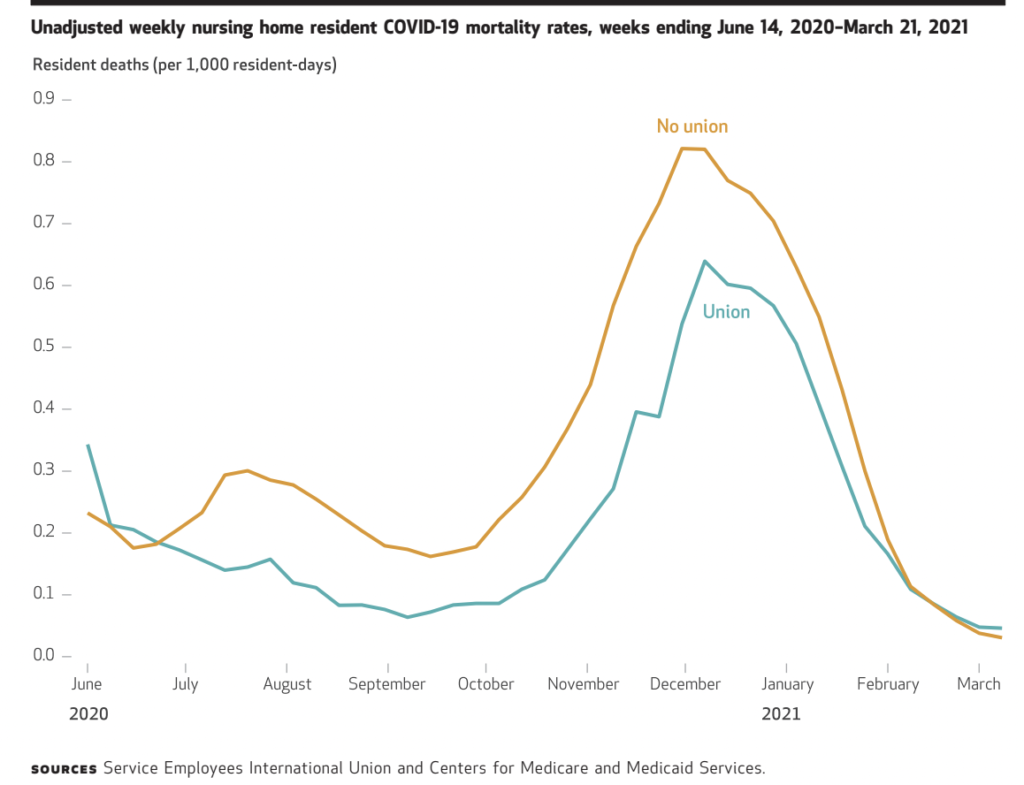Labor unions may play an important role in improving workplace safety, especially for nursing homes in the context of the COVID-19 pandemic.
In fact, having unionized workers in nursing homes has been associated with lower resident COVID-19 mortality, in addition to lower worker COVID-19 infection rates, a study published in Health Affairs this month suggests.
The study looked at 13,350 nursing homes across the country and found that industry-wide unionization would have been associated with approximately 8,000 fewer resident deaths.
“The country has been debating for two years now how to protect essential workers and there seems to be sometimes a national amnesia [when it comes to] labor unions. They have been fighting for better working conditions, for safer jobs for essential workers and they are an important part of the story for protecting essential workers, as well as their broader communities,”said Adam Dean, George Washington University assistant professor of political science and an author of the study.
Dean and the other researchers used data from the Service Employees International Union for all continental U.S. states from June 8, 2020 though March 21, 2021, along with data on nursing home occupancy rates, number of resident days, number of staff days, and CMS’s Five-Star Quality Rating System.
Researchers also used publicly available data from CMS on resident COVID-19 mortality rates.
Unionized nursing home workers were associated with 10.8% lower resident COVID-19 mortality rates and 6.8% lower worker COVID-19 infection rates.

Unionized facilities also had lower licensed practical nurse and certified nursing assistant (CNA) staff-to-resident-hour ratios, according to the data, however, they also had higher registered nurse (RN) staff-to-resident hour ratios.
The percentage of nursing homes that were unionized was highest in the Northeast and lowest in the South, according to the data.
“The impetus for it goes back to a feeling of trying to better understand how we can protect essential workers during the pandemic, who were facing high-risk situations in the workplace,” Dean told Skilled Nursing News.
Making joining a union a little easier
The results of the study come on the heels of the White House’s nursing home reform package that was released earlier this year, which suggests that giving nursing home workers a free and fair choice to join a union could be one way to create better pathways to good-paying jobs for nursing home workers.
The White House called on the Centers for Medicare & Medicaid Services (CMS), in collaboration with the Department of Labor, to work with external entities – including training intermediaries, registered apprenticeship programs, labor-management training programs, and labor unions – to recruit, retain and transition workers into long-term care careers.
“It’s great to see the administration push for reform,” Dean said. “Survey data suggest that something like 65% of workers around the U.S. would like to be in a labor union if given the option so there’s a lot of interest in unionization but the unionization rate is still really low.”
Health care worker unions were present in just 2,242 nursing homes out of the 13,350 in the study’s cohort – or 16.8% of the nursing homes overall, according to the study.
“I think the problem is not getting interest amongst workers, but rather, finding ways to make it easier for workers who are interested in having a union to actually be able to join an organized one,” Dean added.
Since the start of the pandemic, SEIU and other labor unions representing nursing home workers have advocated for numerous policies that may decrease worker infection risk, including paid sick leave, access to personal protective equipment, surveillance SARS-CoV-2 testing and the isolation of infected residents.
Facilities without unions may be especially vulnerable to poor outcomes for patients and workers, according to the study.
This is the second study Dean and the other researchers published about nursing homes and labor unions during the pandemic. The first one looked solely at nursing homes in the state of New York early on in the pandemic, again finding that labor unions were associated with lower COVID mortality rates for residents.
“It did two things: one, it extended it nationally from New York to the continental United States. Second, it looked at a new time period,” Dean explained.
While the first study only looked at the first few months of the pandemic, the new study provided insight into how COVID-19 waves experienced in the summer and winter of 2020 impacted worker infection rates.
“We were able to establish that unions in nursing homes are associated with lower infection rates for workers and as far as I know, this is the first study ever to show that unions were associated with lower worker infection rates,” Dean added.


